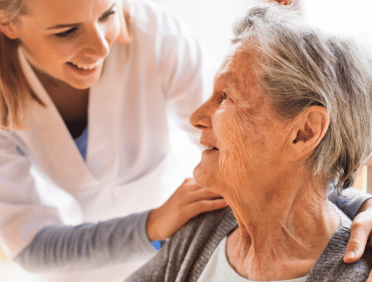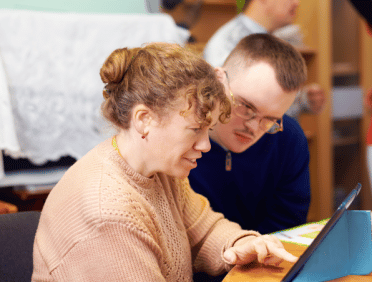As we go through life, we all face certain risks and challenges that we must deal with. For some individuals, however, these risks can be much greater. Adults with care and support needs can face the risk of abuse, harm, ill-treatment, and neglect, and it is vital that we have systems in place to safeguard them. In this blog, we will take a closer look at safeguarding adults at risk, including the policies, procedures, and training required to ensure that vulnerable adults live in safety and security.
What is adult safeguarding?
Adult safeguarding is a term used to describe the process of protecting adults with care and support needs from the risk of harm, abuse, or neglect. It involves identifying individuals who may be at risk, taking steps to prevent harm from occurring, and responding appropriately when harm does occur.
The goal of adult safeguarding is to promote the well-being of individuals with care and support needs and to ensure that they can live their lives in safety, free from abuse, harm, and neglect. This includes protecting them from a range of different types of abuse, including physical, emotional, sexual, and financial abuse.
What is safeguarding level 1 adults?
Safeguarding Level 1 Adults refers to the basic level of training required for those who work with vulnerable adults. This training covers the fundamental principles of safeguarding and aims to provide workers with an understanding of what adult safeguarding is, why it is important, and how to recognize and respond to abuse or neglect.
Safeguarding Level 1 Adults training is typically provided to a wide range of professionals, including healthcare workers, social workers, and care providers. This training is a requirement for many professionals who work with adults with care and support needs, and it is often updated on a regular basis to ensure that workers stay up-to-date with the latest best practices and guidelines.
Who needs safeguarding of vulnerable adults training?
Safeguarding of vulnerable adults training is required for anyone who works with adults with care and support needs. This includes healthcare workers, social workers, care providers, and anyone else who may come into contact with vulnerable adults as part of their job.
It is essential that these professionals receive appropriate training in adult safeguarding to ensure that they can recognize and respond to abuse or neglect. This training should cover the different types of abuse that vulnerable adults may face, the signs and symptoms of abuse, and the appropriate steps to take if abuse or neglect is suspected.
The Care Act 2014 (safeguarding adults)
The Care Act 2014 is a piece of legislation that sets out the legal framework for adult social care in England. Part of this legislation relates specifically to safeguarding adults at risk of abuse or neglect.
The Care Act 2014 places a duty on local authorities to make enquiries when they receive information about an adult who is at risk of abuse or neglect. This includes investigating cases where abuse or neglect is suspected and taking appropriate action to protect the individual from harm.
The legislation also establishes Safeguarding Adults Boards (SABs), which are responsible for overseeing and coordinating adult safeguarding activities within their local area. SABs are made up of representatives from local authorities, healthcare providers, and other relevant organizations, and they work to ensure that effective safeguarding policies and procedures are in place to protect vulnerable adults.
Safeguarding Adults Boards (SABs)
As mentioned above, Safeguarding Adults Boards (SABs) are responsible for overseeing and coordinating adult safeguarding activities within their local area. SABs are made up of representatives from local authorities, healthcare providers, and other relevant organizations, and they work to ensure that effective safeguarding policies and procedures are in place to protect vulnerable adults.
SABs have a number of key responsibilities, including:
- Developing local safeguarding policies and procedures
- Providing training and support to professionals who work with vulnerable adults
- Raising awareness of adult safeguarding issues within the community
- Investigating cases where abuse or neglect is suspected
- Providing support to individuals who have experienced abuse or neglect
- SABs also work closely with other organizations, such as the police, to ensure that vulnerable adults receive the support and protection they need.
Safeguarding Adults Policy and Procedure
Every organization that works with vulnerable adults should have a safeguarding adults policy and procedure in place. This policy should outline the steps that workers should take if they suspect that a vulnerable adult is at risk of abuse or neglect.
The policy should cover a range of different topics, including:
- The types of abuse that vulnerable adults may face
- The signs and symptoms of abuse
- How to report suspected abuse or neglect
- The steps that will be taken to investigate and respond to allegations of abuse
- The support that will be provided to individuals who have experienced abuse or neglect
- Organizations should ensure that all workers receive appropriate training on the safeguarding adults policy and procedure, and that the policy is regularly reviewed and updated to ensure that it remains current and effective.
Who is an adult at risk of harm?
An adult at risk of harm is someone who has care and support needs and who may be unable to protect themselves from abuse or neglect. This includes individuals who are elderly, disabled, or who have a mental health condition.
Some of the factors that may make an individual more vulnerable to harm include:
- Isolation or loneliness
- Physical or mental disabilities
- Cognitive impairment
- Financial or material dependency
- Being a victim of previous abuse or neglect
- It is important to remember that vulnerability can vary over time and that individuals may become more or less vulnerable depending on their circumstances.
Capacity and Consent
When working with vulnerable adults, it is important to consider issues of capacity and consent. Capacity refers to an individual’s ability to make decisions for themselves, while consent refers to an individual’s agreement to a particular action or decision.
Professionals working with vulnerable adults should always assume that individuals have capacity unless there is evidence to suggest otherwise. They should also ensure that individuals are able to provide informed consent to any actions or decisions that are taken on their behalf.
If there are concerns about an individual’s capacity or ability to provide informed consent, then appropriate steps should be taken to assess their capacity and ensure that they are provided with the support they need to make decisions for themselves.
What constitutes abuse and neglect?
Abuse and neglect can take many different forms, and it is important to be aware of the different types of abuse that vulnerable adults may face. Some of the most common types of abuse and neglect include:
Discriminatory abuse
Discriminatory abuse refers to situations where an individual is treated unfairly or differently because of their race, gender, age, disability, or any other characteristic. This type of abuse can be difficult to recognize, but it can have a significant impact on an individual’s well-being.
Financial or material abuse
Financial or material abuse occurs when an individual is exploited financially or has their possessions or property stolen or misused. This can include situations where an individual is pressured into giving away their money or assets or where they are denied access to their own finances.
Modern slavery
Modern slavery is a form of abuse where an individual is exploited for personal or commercial gain. This can include situations where an individual is forced to work in poor conditions, is subjected to physical or emotional abuse, or is denied access to their basic human rights.
Neglect and acts of omission
Neglect and acts of omission occur when an individual’s basic needs are not being met. This can include situations where an individual is not being provided with adequate food, clothing, or shelter, or where they are being denied access to medical care or other essential services.
Organisational abuse
Organisational abuse occurs when an individual is subjected to abuse or neglect within an institution or organization, such as a care home or hospital. This can include situations where an individual is subjected to physical or emotional abuse by staff or is denied access to essential services or support.
Self-neglect
Self-neglect occurs when an individual is unable or unwilling to care for themselves, and their well-being is at risk as a result. This can include situations where an individual is not eating or drinking enough, is living in unsanitary conditions, or is not taking their medication as prescribed.
Physical Abuse
Physical abuse refers to any form of physical harm or violence directed at an individual. This can include situations where an individual is hit, punched, kicked, or restrained inappropriately.
Domestic Violence
Domestic violence occurs when an individual is subjected to abuse or violence within a domestic setting, such as their home. This can include situations where an individual is being emotionally or physically abused by a partner or family member.
Psychological Abuse
Psychological abuse occurs when an individual is subjected to emotional or mental harm. This can include situations where an individual is being bullied, harassed, or subjected to verbal abuse.
Sexual Abuse
Sexual abuse refers to any form of sexual activity that an individual does not consent to or is unable to consent to. This can include situations where an individual is being coerced or pressured into sexual activity, or where they are unable to give consent due to a cognitive or physical impairment.
As we have seen, safeguarding adults at risk is a complex and multifaceted issue that requires a range of skills and knowledge. To ensure that professionals who work with vulnerable adults are equipped to recognize and respond to abuse and neglect, it is essential that they receive appropriate training.
Safeguarding of adult training typically covers a range of topics, including:
- The different types of abuse and neglect that vulnerable adults may face
- The signs and symptoms of abuse and neglect
- How to report suspected abuse or neglect
- The legal and policy frameworks that underpin adult safeguarding
- The importance of capacity and consent in adult safeguarding
- How to work with other professionals to ensure effective safeguarding
Training should be provided on a regular basis to ensure that workers stay up-to-date with the latest best practices and guidelines. It is also important to ensure that training is tailored to the specific needs of different groups, such as healthcare workers, social workers, or care providers.
Learn Q’s Safeguarding Adults Level 1 is an introductory course that provides a basic understanding of safeguarding vulnerable adults. It covers the concept of safeguarding, the importance of safeguarding, the legislation in place to protect vulnerable adults, the signs of abuse and how to avoid them, and how to respond when a vulnerable adult discloses they are being abused or neglected. This course is suitable for anyone who works with vulnerable adults, including managers, supervisors, employees, and volunteers at all levels.
Learn Q’s Safeguarding Adults Level 2 course, on the other hand, is a more advanced course that builds on the knowledge gained in Level 1. It provides a more in-depth understanding of safeguarding, including recognizing abuse, the responsibilities of different safeguarding roles, effective communication, and how to handle concerns and incidents related to safeguarding. This course is designed for those with additional safeguarding responsibilities, such as those who work in hospitals, general practices, nursing homes, care homes, or domiciliary care, as well as in religious organizations and community organizations.
Overall, while both courses cover the essential knowledge and skills needed to safeguard vulnerable adults, Safeguarding Adults Level 2 provides a more comprehensive and detailed understanding of safeguarding, which is important for those who have additional safeguarding responsibilities.
These courses are ideal for those who work in hospitals, general practices, nursing homes, care homes, domiciliary care, as well as in religious and community organizations. By completing this course, you will be better equipped to handle safeguarding concerns and to ensure the safety and well-being of vulnerable adults.
At Learn Q, we are committed to providing high-quality training that meets the needs of professionals across a range of industries. Our Safeguarding Adults courses are designed to provide you with the knowledge and skills you need to excel in your role and make a real difference in the lives of vulnerable adults. Sign up today and take the next step in your career!
In conclusion, safeguarding adults at risk is a vitally important issue that requires a coordinated and comprehensive approach. By ensuring that professionals who work with vulnerable adults receive appropriate training and support, we can help to ensure that individuals with care and support needs are able to live their lives in safety and security. With the right policies, procedures, and training in place, we can work together to create a society that protects and supports all of its members.
To download a .pdf of this blog, please click here












